要将连通与否的信息记录到网络数据库.由于 Linux 和 Windows 的网络接口实现
方式不同,你不得不写两个函数的版本.用 Java 就没有这样的顾虑.
同样的工作用 Python 实现如下:
import subprocess
cmd="cmd.exe"
begin=101
end=200
while begin
找到你保存的 a.py 文件,双击.也可以看到程序结果.Python 的程序能够直接运
行,对比 Java,这是一个优势.
---------------------------------------------------------------------
2.2 国际化支持
我们换一种方式来问候世界.新建一个编辑器并写如下代码:
print "欢迎来到奥运中国!"
raw_input("Press enter key to close this window");
在你保存代码的时候,Python 会提示你是否改变文件的字符集,结果如下:
# -*- coding: cp936 -*-
print "欢迎来到奥运中国!"
raw_input("Press enter key to close this window");
将该字符集改为我们更熟悉的形式:
# -*- coding: GBK -*-
print "欢迎来到奥运中国!" # 使用中文的例子
raw_input("Press enter key to close this window");
程序一样运行良好.
---------------------------------------------------------------------
2.3 方便易用的计算器
用微软附带的计算器来计数实在太麻烦了.打开 Python 解释器,直接进行计算:
a=100.0
b=201.1
c=2343
print (a+b+c)/c
---------------------------------------------------------------------
2.4 字符串,ASCII 和 UNICODE
可以如下打印出预定义输出格式的字符串:
print """
Usage: thingy [OPTIONS]
-h Display this usage message
-H hostname Hostname to connect to
"""
字符串是怎么访问的?请看这个例子:
word="abcdefg"
a=word[2]
print "a is: "+a
b=word[1:3]
print "b is: "+b # index 1 and 2 elements of word.
�
c=word[:2]
print "c is: "+c # index 0 and 1 elements of word.
d=word[0:]
print "d is: "+d # All elements of word.
e=word[:2]+word[2:]
print "e is: "+e # All elements of word.
f=word[-1]
print "f is: "+f # The last elements of word.
g=word[-4:-2]
print "g is: "+g # index 3 and 4 elements of word.
h=word[-2:]
print "h is: "+h # The last two elements.
i=word[:-2]
print "i is: "+i # Everything except the last two characters
l=len(word)
print "Length of word is: "+ str(l)
请注意 ASCII 和 UNICODE 字符串的区别:
print "Input your Chinese name:"
s=raw_input("Press enter to be continued");
print "Your name is : " +s;
l=len(s)
print "Length of your Chinese name in asc codes is:"+str(l);
a=unicode(s,"GBK")
l=len(a)
print "I'm sorry we should use unicode char!Characters number of your
Chinese \
name in unicode is:"+str(l);
---------------------------------------------------------------------
2.5 使用 List
类似 Java 里的 List,这是一种方便易用的数据类型:
word=['a','b','c','d','e','f','g']
a=word[2]
print "a is: "+a
b=word[1:3]
print "b is: "
print b # index 1 and 2 elements of word.
c=word[:2]
print "c is: "
print c # index 0 and 1 elements of word.
d=word[0:]
print "d is: "
print d # All elements of word.
�
e=word[:2]+word[2:]
print "e is: "
print e # All elements of word.
f=word[-1]
print "f is: "
print f # The last elements of word.
g=word[-4:-2]
print "g is: "
print g # index 3 and 4 elements of word.
h=word[-2:]
print "h is: "
print h # The last two elements.
i=word[:-2]
print "i is: "
print i # Everything except the last two characters
l=len(word)
print "Length of word is: "+ str(l)
print "Adds new element"
word.append('h')
print word
---------------------------------------------------------------------
2.6 条件和循环语句
# Multi-way decision
x=int(raw_input("Please enter an integer:"))
if x<0:
x=0
print "Negative changed to zero"
elif x==0:
print "Zero"
else:
print "More"
# Loops List
a = ['cat', 'window', 'defenestrate']
for x in a:
print x, len(x)
---------------------------------------------------------------------
2.7 如何定义函数
# Define and invoke function.
def sum(a,b):
return a+b
�
func = sum
r = func(5,6)
print r
# Defines function with default argument
def add(a,b=2):
return a+b
r=add(1)
print r
r=add(1,5)
print r
并且,介绍一个方便好用的函数:
# The range() function
a =range(5,10)
print a
a = range(-2,-7)
print a
a = range(-7,-2)
print a
a = range(-2,-11,-3) # The 3rd parameter stands for step
print a
---------------------------------------------------------------------
2.8 文件 I/O
spath="D:/download/baa.txt"
f=open(spath,"w") # Opens file for writing.Creates this file doesn't
exist.
f.write("First line 1.\n")
f.writelines("First line 2.")
f.close()
f=open(spath,"r") # Opens file for reading
for line in f:
print line
f.close()
---------------------------------------------------------------------
2.9 异常处理
s=raw_input("Input your age:")
if s =="":
raise Exception("Input must no be empty.")
try:
i=int(s)
except ValueError:
�
print "Could not convert data to an integer."
except:
print "Unknown exception!"
else: # It is useful for code that must be executed if the try clause does
not raise an exception
print "You are %d" % i," years old"
finally: # Clean up action
print "Goodbye!"
---------------------------------------------------------------------
2.10 类和继承
class Base:
def __init__(self):
self.data = []
def add(self, x):
self.data.append(x)
def addtwice(self, x):
self.add(x)
self.add(x)
# Child extends Base
class Child(Base):
def plus(self,a,b):
return a+b
oChild =Child()
oChild.add("str1")
print oChild.data
print oChild.plus(2,3)
---------------------------------------------------------------------
-----------
2.11 包机制
每一个.py 文件称为一个 module,module 之间可以互相导入.请参看以下例子:
# a.py
def add_func(a,b):
return a+b
# b.py
from a import add_func # Also can be : import a
print "Import add_func from module a"
print "Result of 1 plus 2 is: "
print add_func(1,2) # If using "import a" , then here should be
"a.add_func"
module 可以定义在包里面.Python 定义包的方式稍微有点古怪,假设我们有一个
�
parent 文件夹,该文件夹有一个 child 子文件夹.child 中有一个 module a.py .
如何让 Python 知道这个文件层次结构?很简单,每个目录都放一个名为
_init_.py 的文件.该文件内容可以为空.这个层次结构如下所示: parent
--__init_.py
--child
-- __init_.py
--a.py
b.py
那么 Python 如何找到我们定义的 module?在标准包 sys 中,path 属性记录了
Python 的包路径.你可以将之打印出来:
import sys
print sys.path
通常我们可以将 module 的包路径放到环境变量 PYTHONPATH 中,该环境变量会自
动添加到 sys.path 属性.另一种方便的方法是编程中直接指定我们的 module 路
径到 sys.path 中:
import sys
sys.path.append('D:\\download')
from parent.child.a import add_func
print sys.path
print "Import add_func from module a"
print "Result of 1 plus 2 is: "
print add_func(1,2)
---------------------------------------------------------------------
总结你会发现这个教程相当的简单.许多 Python 特性在代码中以隐含方式提出,
这些特性包括:Python 不需要显式声明数据类型,关键字说明,字符串函数的解
释等等.我认为一个熟练的程序员应该对这些概念相当了解,这样在你挤出宝贵
的一小时阅读这篇短短的教程之后,你能够通过已有知识的迁移类比尽快熟悉
Python,然后尽快能用它开始编程.
�
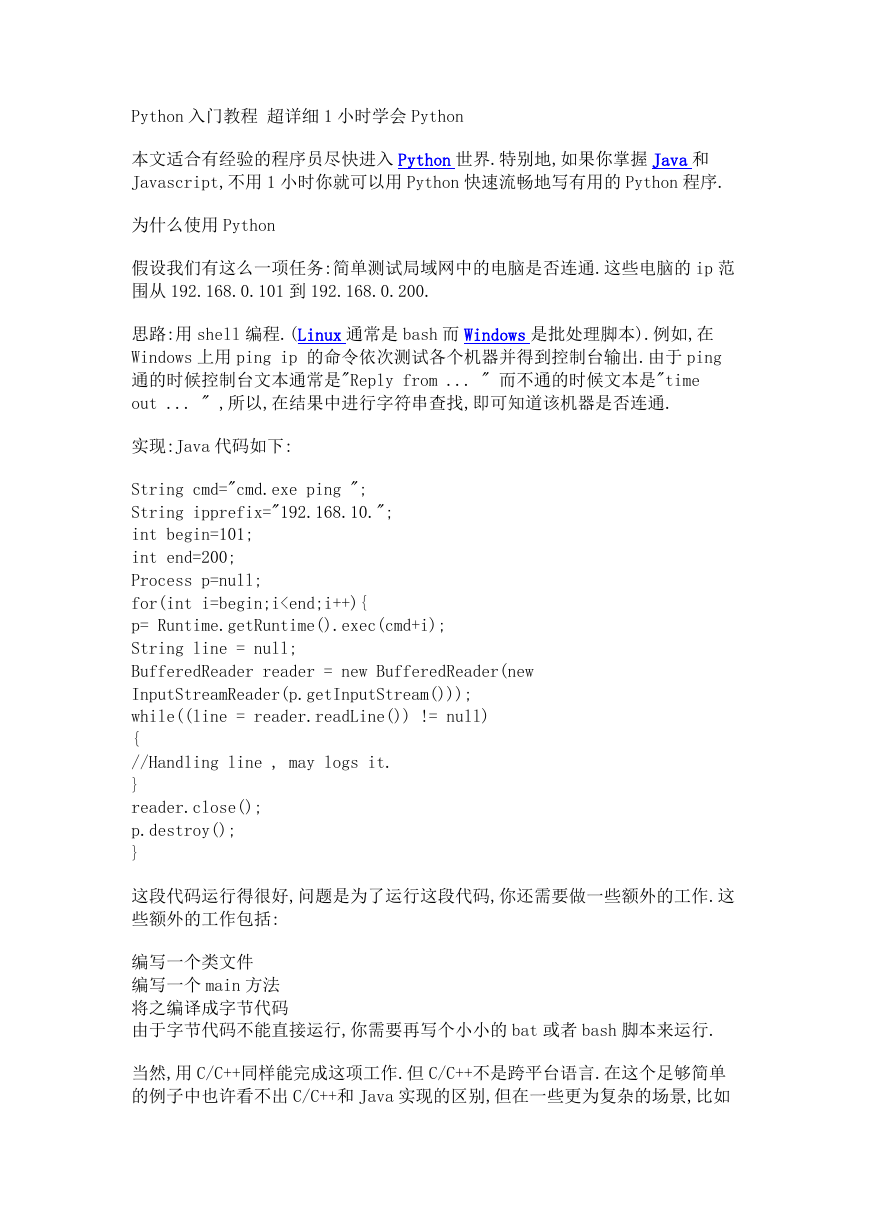
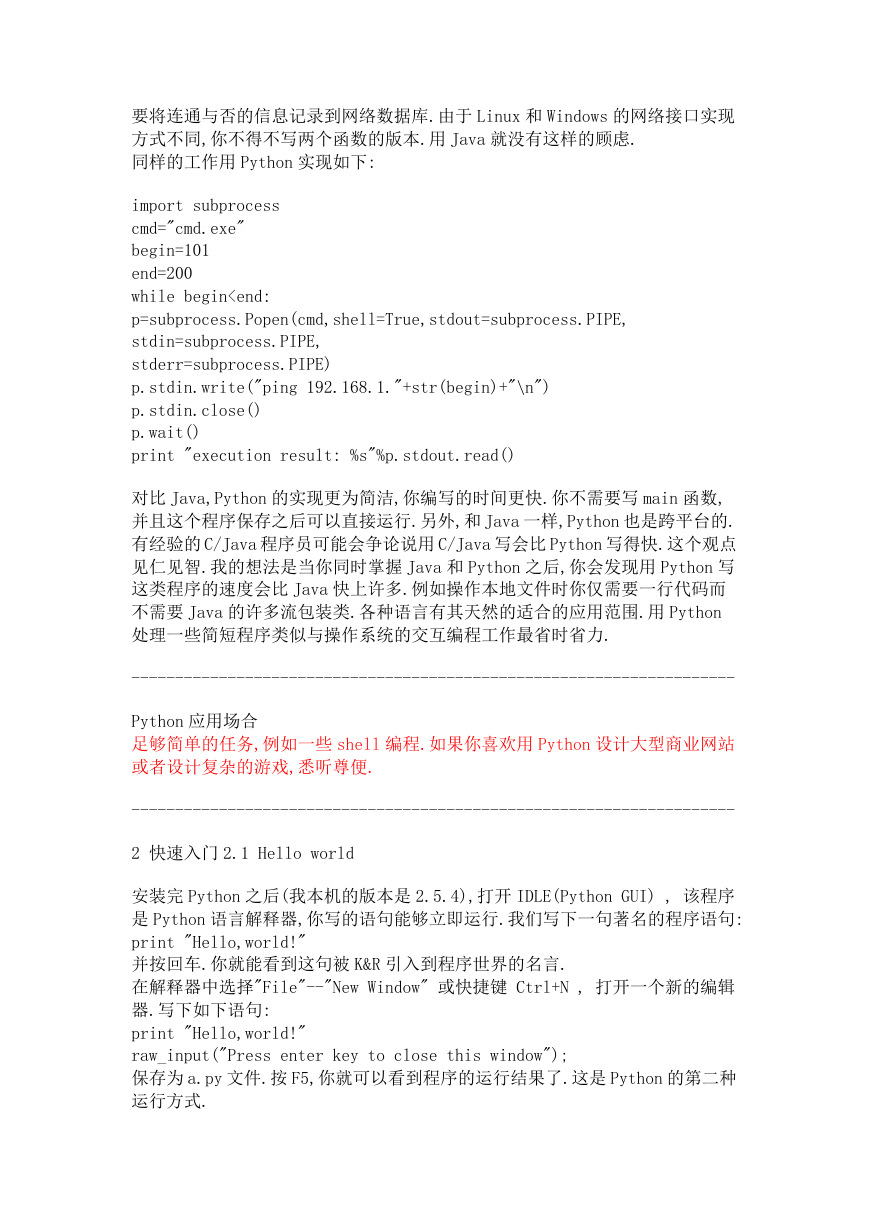

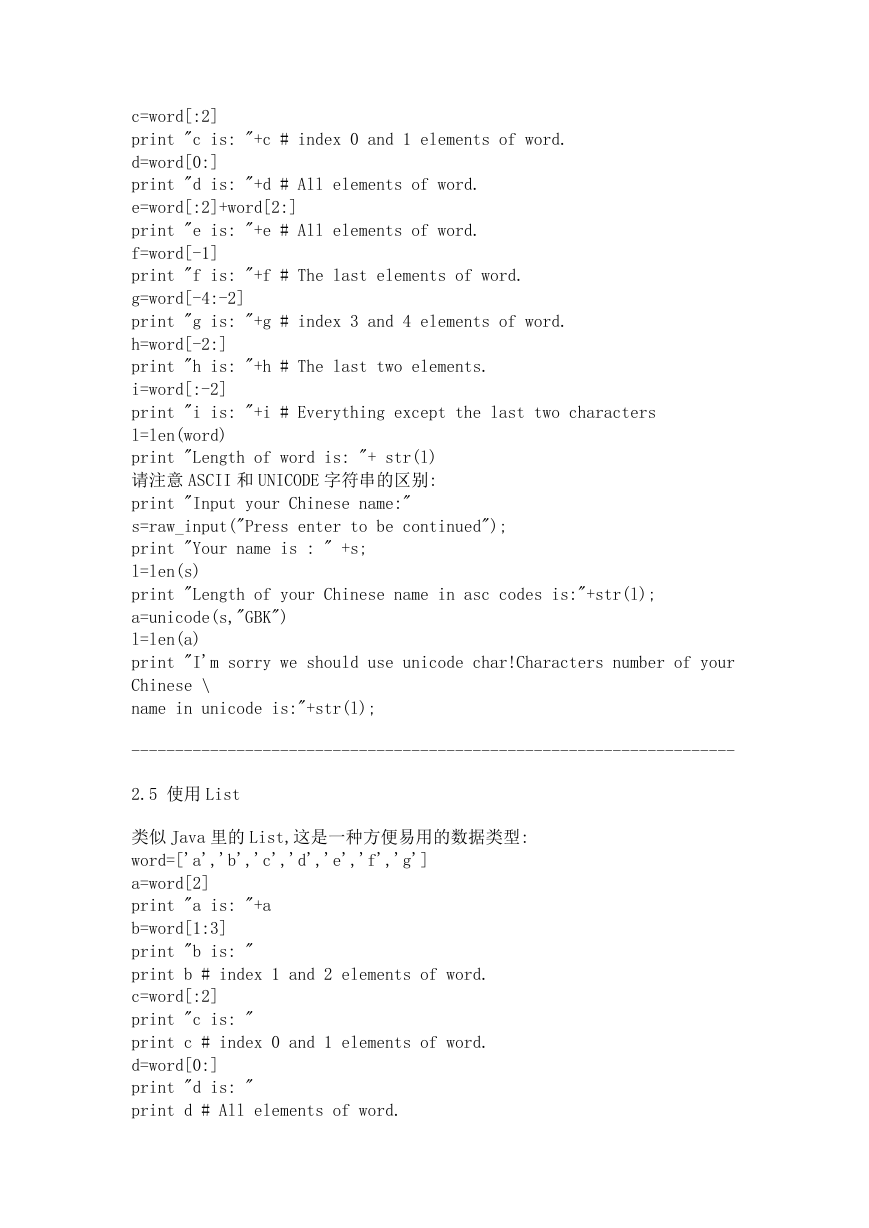

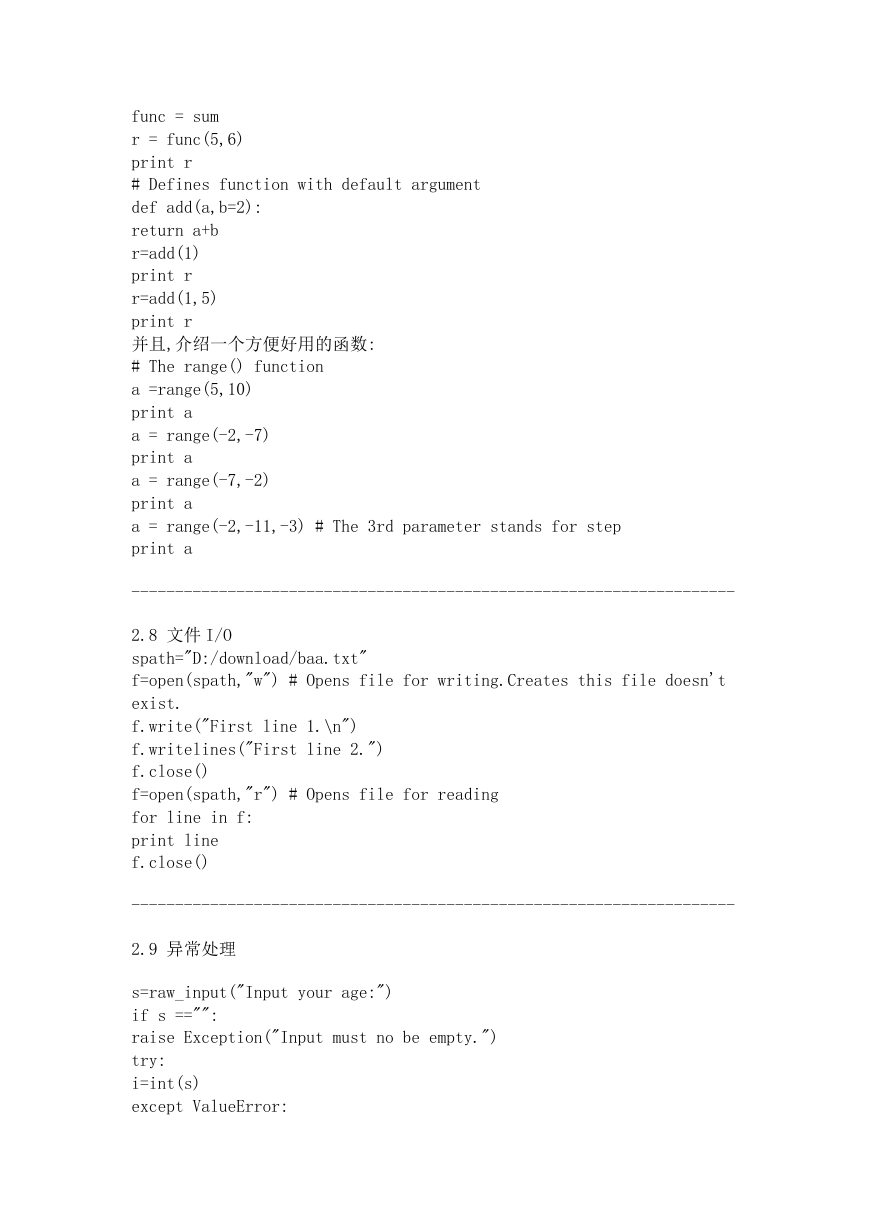
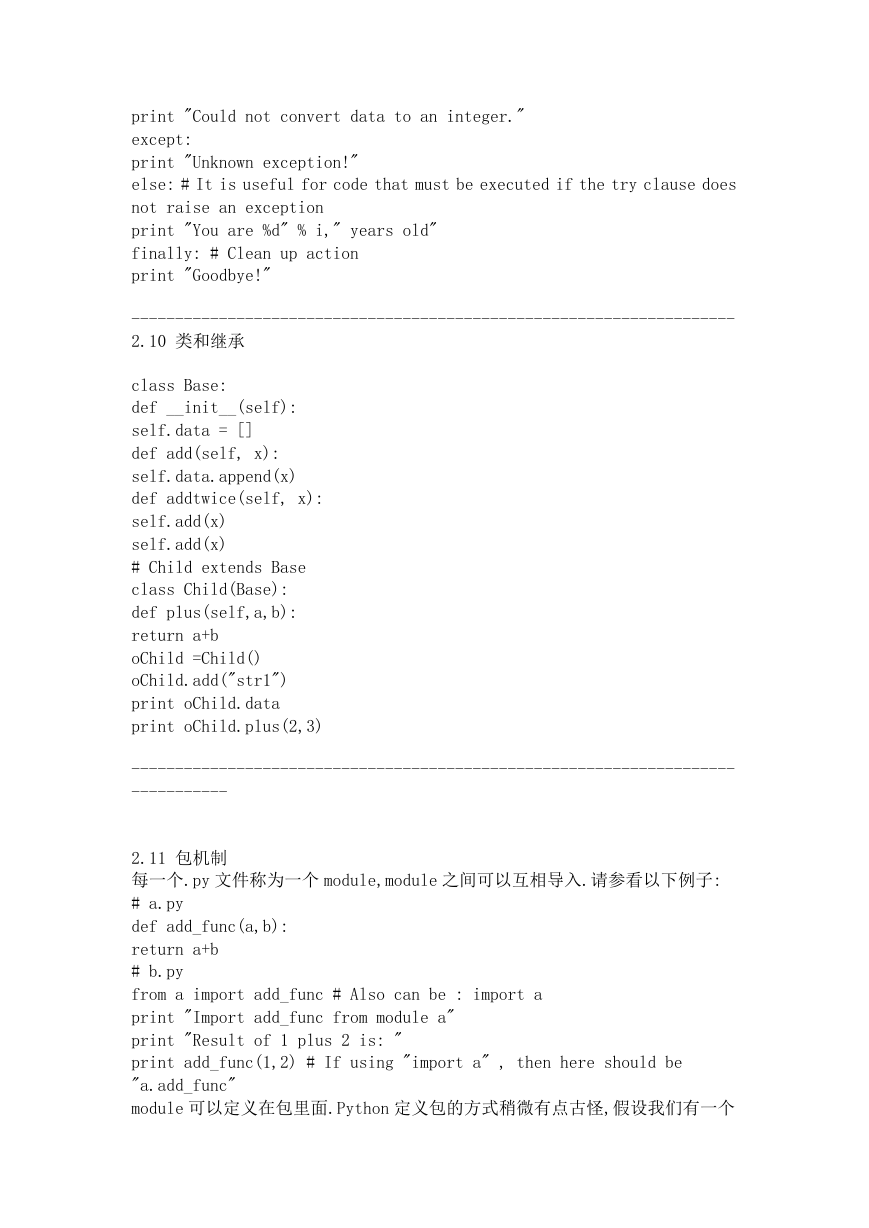
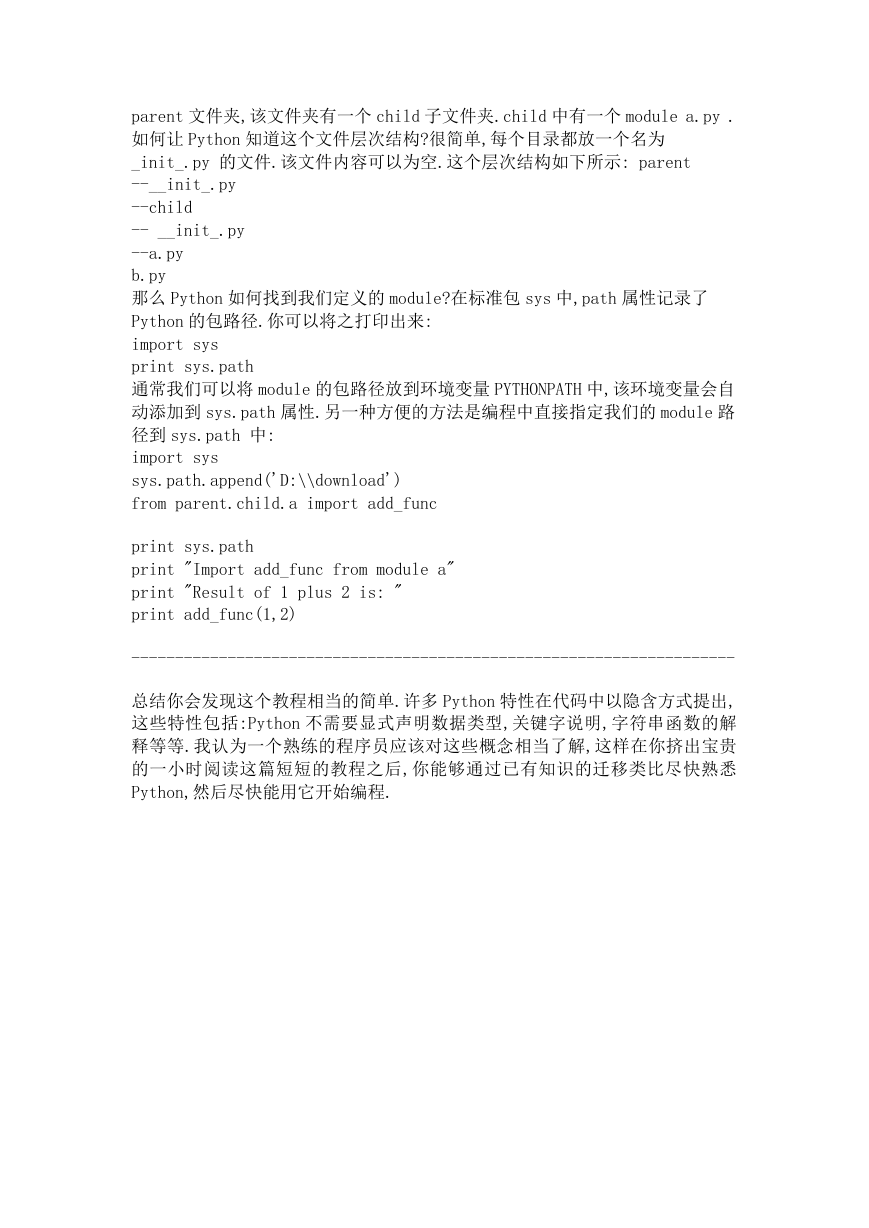








 2023年江西萍乡中考道德与法治真题及答案.doc
2023年江西萍乡中考道德与法治真题及答案.doc 2012年重庆南川中考生物真题及答案.doc
2012年重庆南川中考生物真题及答案.doc 2013年江西师范大学地理学综合及文艺理论基础考研真题.doc
2013年江西师范大学地理学综合及文艺理论基础考研真题.doc 2020年四川甘孜小升初语文真题及答案I卷.doc
2020年四川甘孜小升初语文真题及答案I卷.doc 2020年注册岩土工程师专业基础考试真题及答案.doc
2020年注册岩土工程师专业基础考试真题及答案.doc 2023-2024学年福建省厦门市九年级上学期数学月考试题及答案.doc
2023-2024学年福建省厦门市九年级上学期数学月考试题及答案.doc 2021-2022学年辽宁省沈阳市大东区九年级上学期语文期末试题及答案.doc
2021-2022学年辽宁省沈阳市大东区九年级上学期语文期末试题及答案.doc 2022-2023学年北京东城区初三第一学期物理期末试卷及答案.doc
2022-2023学年北京东城区初三第一学期物理期末试卷及答案.doc 2018上半年江西教师资格初中地理学科知识与教学能力真题及答案.doc
2018上半年江西教师资格初中地理学科知识与教学能力真题及答案.doc 2012年河北国家公务员申论考试真题及答案-省级.doc
2012年河北国家公务员申论考试真题及答案-省级.doc 2020-2021学年江苏省扬州市江都区邵樊片九年级上学期数学第一次质量检测试题及答案.doc
2020-2021学年江苏省扬州市江都区邵樊片九年级上学期数学第一次质量检测试题及答案.doc 2022下半年黑龙江教师资格证中学综合素质真题及答案.doc
2022下半年黑龙江教师资格证中学综合素质真题及答案.doc